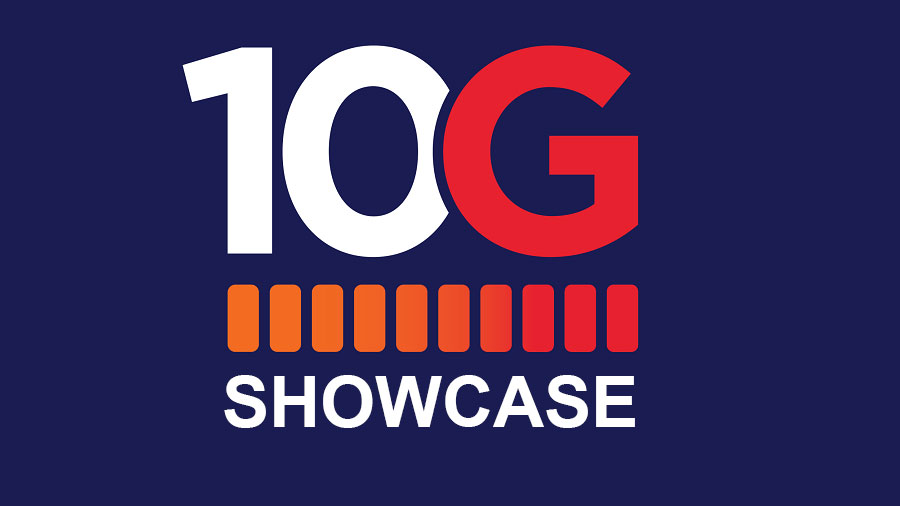Blog
June 15, 2022
Ode to a Very Fast HFC Network
By Joe McGarvey, Senior Director, Marketing |

The American poet T.S. Eliot famously wrote “I have measured out my life in coffee spoons.” Cable industry veterans may have been thinking something similar, with megabits substituting for spoons, when witnessing the April 27th demonstration of a prototype DOCSIS® 4.0 FDD network at this Spring’s 10G Showcase event.
The speed test, conducted by officials from Charter Communications, no doubt transported more than a few long-time cable professionals all the way back to 1996, when Brian Roberts, then NCTA Chairman, performed a similar exhibition in the runup to the rollout of DOCSIS 1.0. Roberts wowed the crowd by retrieving a couple of images from the Internet, using a Netscape browser, none-the-less, at the then-remarkable speed of 10Mbps.
The visual aide for the more-recent speed test was the oversized projection of 8.907Gbps behind Charter’s VP of Engineering John Williams. That number represented the audacious downstream rate registered by the DOCSIS 4.0 prototype network that Williams and his colleague Matt Peters, VP Access Architecture, oversaw at the April 27 event. That’s an increase – from the 10Mbps of 1996 – of 88970%. Or, if you prefer to measure in megabits the 26 years that have elapsed between the two demonstrations, that’s roughly 340Mbps a year. Either way, we’re talking about a heck of a lot of coffee spoons.
All Hail the HFC Network
We couldn’t let this landmark achievement — no surprise, but nevertheless monumental — pass without taking note and without recognizing the contributions of all those engineers and architects, stretching back to 1996 and earlier, responsible for establishing DOCSIS as the most prominent and influential technology for delivering broadband to the masses. Let’s also raise a glass to the HFC network. It too is a remarkable achievement, 30 years in the making, with plenty of gas, we believe, still in the tank.
But ATX is no less proud of its own contributions to that monumental speed test, supplying the taps at the end of that record-breaking cascade.
But ATX is no less proud of its own contributions to that monumental speed test, supplying the taps at the end of that record-breaking cascade. Those same taps, part of ATX’s GigaXtend® XS Series 2GHz Taps and Passives portfolio, have been commercially available for two years and are now lining the outside plants of several production networks. Their availability and participation in the recent demonstration serves as a very real reminder of the near-readiness of DOCSIS 4.0.
Though nearly all other components in the test network, including active devices, were still in the prototype stage, ATX is working diligently to ready its 1.8GHz HFC amplifiers for primetime. While some of the enabling technologies, such as silicon and diplex filtering, move toward completion, ATX is interacting with an ecosystem of component suppliers and operators to ensure that when MSOs are positioned to upgrade their outside plants with DOCSIS 4.0-capable amplifiers they will be able to do so seamlessly and without the need to respace their networks.
In the meantime, ATX is helping cable operators meet current customer demand and fend off competitive threats through strategic mid-and high-split upgrades, which serve as steppingstones to the multigigabit symmetrical Promised Land of DOCSIS 4.0.
The Long Haul
Working side-by-side with our customers to fully realize the massive investments already made in their HFC networks is the embodiment of ATX’s 2050 Project, a long-term HFC initiative we launched a couple of years ago to celebrate the HFC network and its continued prominence long into the future. It was our way of letting our customers know that we are as committed to the evolution of their networks as they are and that ATX will have their backs, in terms of enabling technology, for decades to come.
This Spring’s CableLabs 10G Showcase was a milestone event in the history of the HFC network, but certainly not the last. ATX looks forward to being a participant in the next phase of the evolution of the cable access network, and the next after that. Regardless of how many more Mbps or coffee spoons remain in the lifespan of the HFC network, ATX plans to be there when the last one is counted.

